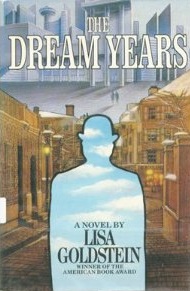The Dream Years (1985) was Lisa Goldstein’s first adult novel, and it’s the first of her books I read. It was nominated for the 1986 World Fantasy Award and is a fantasy about surrealism that is not in itself a surrealist novel—it has characters and a plot and makes sense all the way through. (It’s even possible to argue that it’s science fiction.) It is in any case fantasy treated rigorously. But the effect of reading it is an immersion in the poetic imagination of revolutionary Paris. I’ve always loved it.
It’s 1924. Robert St. Onge is a surrealist, a friend of Andre Breton, though after seven years he has doubts about Andre and the whole surrealist movement. He buys a strange unplayable record in a flea market in Paris, a record with a coloured photograph of a woman who he later meets. She is Solange, and she wants to recruit Robert to help with the revolution of 1968. But it’s not 1968 that needs them, but a revolution of the even further future that calls on the two of them, and the other surrealists too, to fight a war of imagination against enemies from the unconscious darkness.
This is a very unusual book. Paris, in all its eras, is very precisely evoked. Paris is the real central character. Paris in 1924, in 1968, in the far future, but still with a Metro. Whatever else is made up, Paris is real and solid and full of real things and people. The book begins:
The flea market in Saint-Ouen: war medals, glass taxidermists eyes, a bicycle wheel, a leopard’s skin, a pack of cards, an acrobat’s costume (for Helene?) with half the pink sequins gone.
A fortune teller in the market tells Robert he will go on a far journey… to Paris. Robert is always uncertain, he was shell-shocked, he has found a better way to live but he’s funded by his rich family’s tolerance. He also wants to write a novel even though Andre disapproves of the form. He falls in love with Solange after remarkably little real contact. He keeps stepping through time with surprisingly little surprise—he’s enough of a surrealist that when surrealistic things literally happen, he goes along with them. He is our guide through the story, but he’s a guide who isn’t sure of the way.
The Revolution is another major character, but it’s a very undefined revolution. The book always makes me think of the lines from Al Stewart’s “The Palace of Versailles”:
The ghost of revolution
Still prowls the Paris streets
Down all the restless centuries
It wonders incompleteIt speaks inside the cheap red wine
Of cafe summer nights
Its red and amber voices
Call the cars at traffic lights
The revolution is a thing in itself, it isn’t specified, except that it is for individualism against the grind of expectation. The 1968 revolution and the far future one mention strikes, but all we see people doing is sitting around and fighting surrealistically. The text seems to have no more idea what the new world will be like than Robert does. But this is all right, in many ways this is better, because it allows us to fill in our own Parisian revolution. The real enemy seems to be the voice that says “You must go back to work.”
The mechanism of the magic isn’t explained. Both the time travel and the creation of surrealistic objects to fight the army seem to be done through the mind. There’s a lovely scene where a piano and a chandelier stop a tank, and where a soldier’s rifle becomes a fish in his arms. It’s fighting with the power of whimsy.
The Dream Years is a short book but an intense one. Like all Goldstein’s work it’s beautifully written and full of marvelous lingering imagery.
Jo Walton is a science fiction and fantasy writer. She’s published eight novels, most recently Half a Crown and Lifelode, and two poetry collections. She reads a lot, and blogs about it here regularly. She comes from Wales but lives in Montreal where the food and books are more varied.










